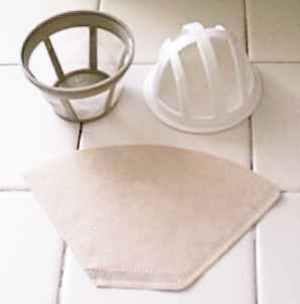Paper and permanent reusable coffee filters both offer some advantages and drawbacks regarding cost, convenience, filtering quality, health, disposal, and environmental impact. Read on for details on how paper coffee filters compare versus permanent nylon or gold filters…
PAPER/DISPOSABLE
Paper coffee filters, which can be purchased in white/bleached or unbleached (brown) versions, generally have the best filtering ability and a lower initial cost. They do not need to be cleaned out, although they take slightly longer to insert than permanent coffee filters. Unless the paper filter is inserted improperly or collapses while the coffee is brewed, it will usually filter out nearly all of the grounds/particles. These are available at many different stores and multiple packages can be purchased for the price of a permanent filter.
On the other hand, they have a continuing effect on the environment, can run out, and need to be disposed of. Using bleached paper filters, usually white, may have harmful health and environmental effects. I have not noticed any difference between the taste of coffee produced with bleached paper filters and the brown, unbleached type. I’ve had good results with both Melitta and Hannaford brands. I have found that getting the sides of the filters wet so that they stick to the sides of the filter holder helps to prevent them from collapsing.
REUSABLE/PERMANENT
Permanent filters are available in multiple types, including nylon, cloth, and gold. They have several advantages; the on-going cost of paper filter buying is eliminated, they generate less waste (and are more environmentally friendly), and there is no risk of running out of them. On the other hand, they cost more to initially purchase (unless they come with a coffee maker) and they generally do not filter grounds quite as thoroughly as paper filters do.
I have a small one-cup permanent plastic filter which came with an old Black & Decker coffee maker, but it usually lets through a number of small grounds, making it necessary to dispose of grounds at the bottom of the carafe. The Aroma ABT-203 comes with a better-designed four cup permanent coffee filter; I found this to be more effective, but it still let through many small particles when using New England Coffee “Breakfast Blend.” Using a #2 paper filter in the ABT-203 produces better quality coffee, although it seems as if the caffeine’s effect may be somewhat weaker due to the more thorough filtering.
Using a coffee with larger grounds (or grinding coffee beans with a grinder which has a setting for larger grounds) would likely increase the filtering effectiveness. Gold permanent filters are more expensive, but probably have greater durability; I haven’t tried them. Permanent filters in some sizes (such as 4-cup) are harder to find than equivalent paper filter packages.
CONCLUSION
There is no clear choice as to whether reusable permanent or disposable paper filters are best; the right type to choose partially depends upon your budget and what type of coffee you use. Permanent filters generally are best in the areas of convenience, ongoing cost, and environmental impact, while the main advantages of paper filters are their low initial cost and better ability to filter out small particles.
